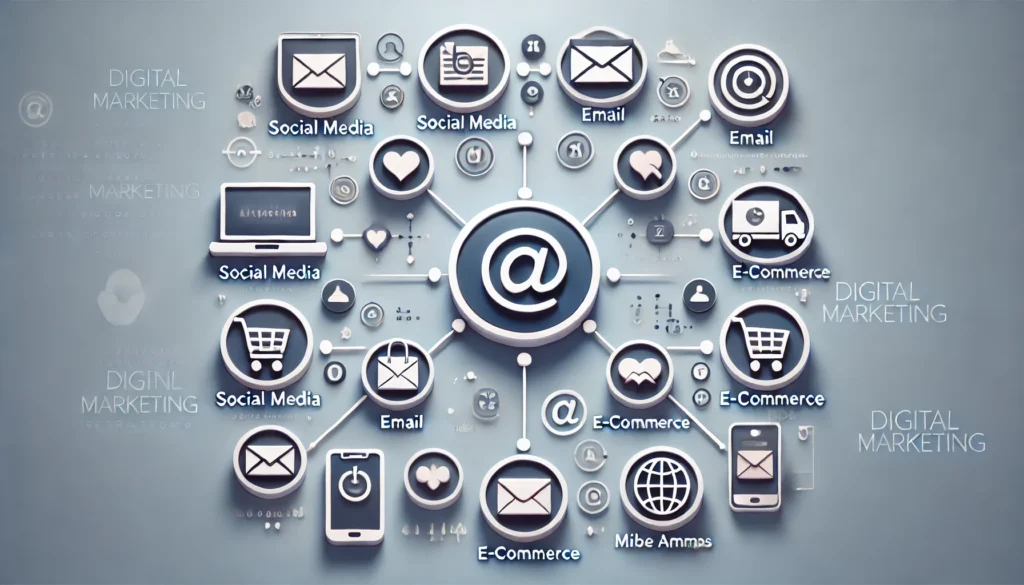Over 73% of customers use multiple channels during their purchasing process, yet most businesses fail to provide a cohesive experience. This inconsistency leads to brand equity loss and declining customer satisfaction.
Today’s consumers expect seamless interactions, whether they’re shopping online, engaging with social media marketing, or visiting physical stores. When messaging is inconsistent across these marketing channels, it creates confusion, weakens brand identity, and ultimately hurts customer retention.
To build a strong brand, businesses must:
- Maintain a consistent customer experience across all their channels.
- Align marketing efforts with a strong company mission.
- Use data analytics to optimize customer interactions and refine strategies.
An enhanced customer experience isn’t just a luxury—it’s a necessity for business growth. This guide will expose how to create an effective omnichannel strategy that strengthens brand loyalty, improves customer engagement, and ensures long-term success.
Understanding Omni-Channel Marketing & Brand Identity

What is Omni-Channel Marketing?
Omni-channel marketing goes beyond simply using multiple channels, it’s about integrating every customer touchpoint into a unified experience. Whether a customer engages via social media platforms, email marketing, mobile apps, or in-store shopping, the brand’s presence must feel seamless and interconnected.
For example, a customer browsing a product on a brand’s website should receive personalized recommendations in an email, followed by a tailored ad on social media. If they visit a physical store, sales associates should have access to their previous online interactions. This approach ensures a cohesive experience that makes them feel valued.
Why Brand Identity Matters in Omni-Channel Marketing
A strong brand identity ensures that every customer interaction aligns with your company’s mission and values. When businesses fail to maintain brand consistency, they risk customer confusion, reduced engagement, and a weaker competitive position.
Core Principles of a Strong Brand Identity
- Consistency – Unified branding across different channels, from social media to in-store experiences.
- Personalization – Using customer data to create a customized experience that resonates with your target audience.
- Seamlessness – A frictionless customer journey that encourages loyalty and engagement.
Companies that invest in corporate branding and align their messaging across marketing channels gain higher brand recognition, stronger brand equity, and better long-term customer relationships.
The Role of Customer Experience in Omni-Channel Marketing
Why Customer Experience is Essential
Consumers today demand consistent customer experiences across social media, mobile apps, and physical stores. When businesses fail to deliver a seamless transition between these platforms, it leads to customer frustration, lower brand loyalty, and lost revenue.
Common Customer Experience Challenges
- A disjointed customer journey, where online and offline interactions don’t align.
- Poor customer satisfaction due to inconsistent messaging and branding.
- Lack of customer data integration makes personalization difficult.
Solutions for a Better Omni-Channel Experience
- Unify customer data across all the channels to provide a personalized experience.
- Ensure consistency in branding, communication, and support.
- Leverage AI and automation to anticipate customer behavior and improve response times.
A well-executed omnichannel approach enhances brand loyalty, helps attract customers, and drives business growth. Brands that prioritize an integrated customer experience will stand out in today’s competitive market.
Building Brand Loyalty with an Effective Omni-Channel Strategy

Why Brand Loyalty is Harder Than Ever
With more choices than ever, customers expect seamless interactions across platforms. If businesses fail to deliver a consistent experience, they risk losing customer trust and loyalty. Studies show that customers are more likely to stay engaged with brands that offer personalized, convenient, and connected interactions across multiple channels [Harvard Business Review].
Key Strategies for Strengthening Brand Loyalty
- Personalized Experiences – Leverage customer data to provide tailored recommendations and relevant offers. Customers appreciate brands that recognize their preferences and anticipate their needs.
- Consistency Across All Channels – Maintain strong brand equity by ensuring that messaging, visuals, and interactions remain uniform, whether on social media, email, or in-store [McKinsey & Company].
- Customer Engagement Beyond Transactions – Build long-term customer relationships by creating a loyalty program, encouraging social media interactions, and delivering value beyond just purchases [HubSpot].
Business Impact
Brands that implement an effective omnichannel strategy experience higher customer retention rates, improved customer satisfaction, and stronger brand recognition. Companies that prioritize seamless customer experiences gain a significant competitive advantage in their industry [Gartner].
Creating a Cohesive Brand Message Across Channels
The Challenge of Brand Consistency Across Different Channels
With customers engaging on multiple platforms, ensuring a unified brand message can be difficult. When marketing teams work in silos, it often leads to fragmented communication, weakening brand identity and reducing brand recognition.
Steps to Unify Brand Messaging
- Develop Clear Brand Guidelines – Define tone, messaging, and visual identity to ensure all communications align [Lucidpress].
- Use a Centralized Content System – Organize marketing efforts to maintain consistency across platforms.
- Train Internal Teams – Ensure marketing, sales, and customer service teams understand branding and marketing best practices to maintain a unified experience.
Example of Strong Brand Messaging
Apple is a leading example of cohesive branding, ensuring that its minimalist, high-quality messaging remains consistent across advertisements, retail stores, and digital content. A well-defined brand identity fosters trust and reinforces a company’s mission statement in the minds of customers.
Business Impact
A cohesive experience across all marketing channels increases customer trust and helps meet customer expectations. Businesses that successfully align branding across multiple channels are more likely to see improved brand loyalty and customer engagement.
The Role of Data & Technology in Omni-Channel Marketing
Why Data is the Backbone of Omni-Channel Marketing
Data-driven insights allow businesses to understand customer behavior, optimize interactions, and improve engagement. Companies that effectively use customer data can provide personalized experiences and increase sales [Salesforce].
Key Technologies for an Effective Omni-Channel Strategy
- Customer Data Platforms (CDPs) – Consolidate customer interactions across multiple channels to create a comprehensive view of consumer behavior [Segment].
- AI and Machine Learning – Automate personalized recommendations, customer segmentation, and targeted marketing efforts.
- Marketing Automation Tools – Streamline communication and campaign execution across various marketing channels.
Overcoming Data Silos
Many businesses struggle with disconnected customer data across sales channels and customer touchpoints. After integrating all available data sources, brands can enhance personalization and improve overall customer satisfaction.
Business Impact
Data-driven marketing strategies contribute to stronger brand equity and a more competitive position in the marketplace. Companies that utilize data analytics effectively can refine their omnichannel approach and achieve long-term success [Gartner].
Measuring Success: How to Track and Optimize Your Omni-Channel Strategy

Key Metrics for Measuring Omni-Channel Performance
Tracking the right performance indicators is essential for assessing the effectiveness of an omnichannel strategy. Businesses should focus on:
- Customer Retention Rate – Measures brand loyalty and the effectiveness of an integrated customer experience.
- Conversion Rates Across Sales Channels – Identifies high-performing touchpoints and areas for optimization.
Best Practices for Continuous Improvement
- Regularly Collect Customer Feedback – Conduct surveys and analyze online reviews to identify friction points.
- A/B Test Marketing Strategies – Experiment with different messaging and formats to refine engagement.
- Use Data Analytics to Monitor Market Trends – Leverage insights to adjust strategies and improve customer experiences. [Gartner]
Common Pitfalls & How to Avoid Them
Mistake #1: Treating Each Channel Separately
Why it’s a problem: Customers expect a unified experience, but many brands still treat online and offline interactions as independent entities.
Solution: Implement integrated customer data platforms (CDPs) to create a single customer profile across all interactions. [Segment]
Mistake #2: Ignoring Personalization
Why it’s a problem: A generic, one-size-fits-all approach leads to disengagement. Customers are more likely to interact with brands that offer customized experiences.
Solution: Use AI-driven marketing automation to analyze customer behavior and deliver personalized content.
Mistake #3: Failing to Align Teams & Strategies
Why it’s a problem: When marketing, sales, and customer service teams work in silos, it results in inconsistent messaging and missed opportunities.
Solution: Develop internal training programs to ensure that all departments follow the same branding and marketing strategy.
The Future of Brand Success Lies in Omni-Channel Marketing
A strong brand identity and a consistent customer experience are essential for business growth. An effective omnichannel strategy strengthens brand equity, fosters long-term customer relationships, and enhances customer satisfaction.
By integrating personalization, data-driven decision-making, and unified branding, businesses can build lasting connections with their audience. Brands that embrace omnichannel marketing not only gain a competitive advantage but also future-proof their business by meeting evolving customer expectations.
However, executing a seamless omnichannel strategy requires the right tools, insights, and continuous optimization. To take your brand’s omnichannel marketing to the next level, explore innovative solutions that help streamline customer interactions and enhance engagement.
Visit Appsecute to discover how technology can empower your business with data-driven strategies, automation, and seamless integration across all marketing channels.
